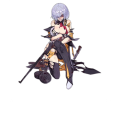Ranking of this Doll's specs relative to other Dolls of the same type.
Thompson: Difference between revisions
Pootis man (talk | contribs) No edit summary |
No edit summary |
||
| (42 intermediate revisions by 18 users not shown) | |||
| Line 1: | Line 1: | ||
{{ | {{PlayableUnit | ||
| | |index = 16 | ||
|nationality = | |nationality = United States | ||
|classification = | |classification = SMG | ||
|rarity = 5 | |rarity = 5 | ||
| | |faction = [[Griffin & Kryuger]] | ||
| | |manufactureringame = [[I.O.P.]] | ||
|manufacturer = Auto-Ordnance Company (originally), The Birmingham Small Arms Company Limited, Colt, Savage Arms, RPB Industries | |||
|artist = {{artist name|NS}} (Original Artist);<br /> | |||
{{artist name|小枪}} (Infernal Hannya) | |||
|fullname = Thompson Submachine Gun | |||
|voiceactor = {{voice actor name|Taneda Risa}} | |||
|releasedon = {{doll_server_alias|server=CN|alias=汤姆森|year=2016|month=5}}, {{doll_server_alias|server=TW|alias=湯姆森}}, {{doll_server_alias|server=KR|alias=톰슨}}, {{doll_server_alias|server=EN|alias=Thompson}}, {{doll_server_alias|server=JP|alias=トンプソン}} | |||
|weaponinfo = | |||
The Thompson submachine gun is an American submachine gun invented by John T. Thompson in 1918 during World War I. The weapon became infamous during the Prohibition era, being a signature weapon of various organized crime syndicates in the United States as well as being wielded by the lawmen that hunted them. It is also famous for its use as an infantry weapon for Allied troops, as almost 20 years after it was initially designed, the Thompson would finally see its first true wartime experience in the hands of British soldiers as World War 2 broke out in Europe. Its use as both a tool of the mafia and of the army has granted the Thompson considerable significance in popular culture, and is one of the most well known and recognized firearms in history.<ref>[[wikipedia:Thompson submachine gun|Wikipedia entry on Thompson]]</ref> | |||
American officer John Thompson came up with the original design of the submachine gun during the later years of the First World War. He had originally envisioned an automatic rifle to replace the bolt action service rifles then in use, such as the American M1903 Springfield. While searching for a way safely cycle the action without the complexity of a recoil or gas-operated reloading mechanism, Thompson came across a patent issued to John Bell Blish several years earlier. Blish's design was based on the adhesion of inclined metal surfaces under pressure, and the concept seemed to be exactly what Thompson had been looking for. With financial backing from a wealthy New York businessman, Thompson would set up the Auto-Ordinance Company in 1916, with the goal of developing his self-loading rifle concept further. By late 1917, the limits of the Blish system were discovered; rather than working as a locked breech, it functioned more like a friction-delayed blowback action. Because of this, the only cartridge currently in service with American forces that was suitable for use with the Blish lock was the .45 ACP pistol round. | |||
Armed with this new knowledge, Thompson came up with a new idea: a "one-man, hand-held machine gun" in .45 ACP that soldiers could utilize as a "trench broom" for use in the ongoing stalemate of trench warfare. Oscar V. Payne, one of the primary designers at Auto-Ordinance, was responsible for designing the new gun, as well as magazines to go with it. This new submachine gun project would be designated as the 'Annihilator', and by 1918 most of the design issues had been ironed out. However, the weapon would never see use in the war for which it was designed, as World War 1 ended just two days before the first batch of prototypes was set to be shipped to Europe. With the war now over, the weapon was officially renamed the "Thompson Submachine Gun". While other weapons had been developed shortly prior with similar objectives in mind, the Thompson was the first weapon to be labeled and marketed as a "submachine gun". | |||
The first model of the Thompson offered to civilians was the M1921. It featured an adjustable rear sight, a finned barrel, the iconic vertical foregrip, and utilized the Blish locking principle.<ref name = "forgotten weapons m1921">[https://www.youtube.com/watch?v=QN1uUfMCQ0Y Forgotten Weapons video on the M1921 Thompson]</ref> When it was first launched, sales were rather low, as the gun was incredibly expensive: a Thompson gun with one Type XX 20 round box magazine was priced at $200 in 1921 (equivalent to $2,867 in 2019). M1921 Thompsons were sold in small quantities to the United States Postal Inspection Service to protect the mail from a spate of robberies. Sales would also be made to the US Marine Corps, as well as several police agencies. Despite the Thompson being marketed as an 'anti-bandit gun', the Thompson achieved most of its early notoriety in the hands of Prohibition and Great Depression-era gangsters, and in Hollywood films about their exploits. In 1928, a modified version of the M1921 was produced as part of a special request by the US Navy. The major modification made was to lower the fire rate down to around 600 rounds per minute. | |||
With the threat of a new global war looming in 1938, Auto-Ordnance made further modifications on the Thompson. They dropped the Thompson's complex Blish lock for a much more simple blowback action, removed the iconic slanted foregrip, moved the charging handle to the side of the receiver, and swapped out the rear ladder sight for a much easier to produce aperture sight. The changes to the bolt made the new model incompatible with the Thompson's drum magazines, which were noted as being cumbersome and noisy. With this modified Thompson, 20 & 30 round stick mags would be used instead. These models came to be known as the M1 and M1A1 Thompson, and it was this version of the Thompson that American troops would carry with them into the Second World War.<ref name = "forgotten weapons m1a1">[https://www.youtube.com/watch?v=1_8qLFoMzl4 Forgotten Weapons video on the M1A1 Thompson SMG]</ref> The U.S. Marines used the Thompson as a limited-issue weapon during combat in the Pacific theater, especially during their later island assaults. The Thompson was soon found to have limited effect in heavy jungle cover, where the low-velocity .45 bullet would not penetrate most small-diameter trees or protective armor vests. Many patrols soon began employing the Browning Automatic Rifle in its place as a point defense weapon. | |||
The US Army introduced the much simpler to produce M3 and M3A1 submachine guns in 1943, with plans to produce the latter in numbers sufficient to cancel future orders for the Thompson, while gradually withdrawing it from the first-line service. However, due to unforeseen production delays and requests for modifications, the M3 'Grease Gun' never replaced the Thompson, and purchases continued until February 1944. Though the M3 was considerably cheaper to produce, at the end of World War II, the Thompson, with a total wartime production of over 1.5 million, outnumbered the M3/M3A1 submachine guns in service by a margin of nearly three to one. | |||
|min_dmg= 12 | |min_dmg= 12 | ||
|max_dmg= 31 | |max_dmg= 31 | ||
|min_eva= 8 | |min_eva= 8 | ||
|max_eva= | |max_eva= 56 | ||
|min_acc= 2 | |min_acc= 2 | ||
|max_acc= 12 | |max_acc= 12 | ||
|min_rof= 57 | |min_rof= 57 | ||
|max_rof= | |max_rof= 82 | ||
|min_hp= 119 | |min_hp= 119 | ||
|max_hp= 238 | |max_hp= 238 | ||
|mov = 12 | |mov = 12 | ||
|craft= 2:30:00 | |craft= 2:30:00 | ||
|aura1= Affects assault rifles | |aura1= Affects assault rifles | ||
|aura2= Increases damage by 12% | |aura2= Increases damage by 12% | ||
|aura3= Increases evasion by 15% | |aura3= Increases evasion by 15% | ||
|tile1= 1 | |tile1= 1 | ||
|tile7= 1 | |tile7= 1 | ||
|tile5 = 0 | |tile5 = 0 | ||
| | |costume1 = Demon Huntress | ||
| | |costume2 = Infernal Hannya | ||
| | |costume3 = costume3 | ||
| | |||
| | |gallery=<gallery> | ||
File:Thompson_S.png|Profile image | |||
File:Thompson.png|Full artwork | |||
File:Thompson_D.png|Full damaged artwork | |||
File:Thompson_costume1.png|"Demon Huntress" artwork | |||
File:Thompson_costume1_D.png|"Demon Huntress" damaged artwork | |||
File:Thompson_costume2.png|"Infernal Hannya" artwork | |||
File:Thompson_costume2_D.png|"Infernal Hannya" damaged artwork | |||
File:Thompson_costume3.png| | |||
File:Thompson_costume3_D.png| | |||
</gallery> | |||
|galleryAlt=<gallery> | |||
File:Thompson_D (Censored).png|Full damaged artwork (Censored) | |||
File:Login Wallpaper 2017 November Illustrated by Infukun.jpeg|Princes' Frontline 2017 login wallpaper illustrated by Infukun | |||
File:Basic Deductions Login Wallpaper.png|"Basic Deductions" Login wallpaper illustrated by ??? | |||
</gallery> | |||
[[Category: | |trivia = | ||
*A pair of M1921 Thompsons were used by members of Al Capone's gang during the St. Valentine's Day Massacre, one of the most infamous acts of gang violence in American history. These guns are still held by the Berrien County Sheriff's Department to this day. | |||
**It was incidents like the St. Valentine's Day Massacre that helped to cement the image of the Thompson in American popular culture. | |||
*In 1941, an attempt was made by the Auto-Ordnance Company to chamber the Thompson with the .30-caliber carbine round, the standard round for the M1 Carbine. Compared with the M1 Carbine, the Thompson Light Rifle (as the modified version was dubbed) could fire the .30 carbine full-auto, whereas the M1 Carbine was a semi-automatic. However, despite its favorable performance in testing by the US Army, the Thompson Light Rifle was deemed too heavy and cumbersome to fit the desired role. Additionally, it was deemed too costly, and was dropped in favor of the M2 Carbine, a fully-automatic iteration of the M1 Carbine.<ref>[[wikipedia:Thompson Light Rifle|Wikipedia entry on .30 Carbine Thompson Modification]]</ref> | |||
*Many WWII shooter games feature 50-round drum mags for the Thompson. In reality, only some Thompsons entered into service during WWII had the ability to use drum mags; drum mags were deemed too heavy to be deployed in combat, especially during reloading which took more time over the 20-30 round stick magazines. Furthermore, the drum mag prone to rattling and took up more space in a bag. | |||
**However, towards the end of 1944, Marine Raiders and tank crews were issued with 50-round drum mags, mostly during Battle of Okinawa. | |||
*So far, Thompson is the ONLY 5* SMG that can be obtained with the base amount of resources (30 points). | |||
*While Thompson's evasion rate is particularly low among 5* SMG T-dolls, her HP (the highest in the SMG class) and active skill make her an extremely effective front-liner, particularly in so-called 'bomb disposal' squads designed to cheese through Red Golyats. | |||
*The model of Thompson portrayed in the game is the 1927A1 semi-automatic carbine produced by Kahr. It has an 18" barrel as opposed to the original Thompson submachine-gun's 10" barrel.<ref>[https://shopkahrfirearmsgroup.com/firearms/thompson-t1.asp 1927A-1, Deluxe Carbine, .45 Cal. - Kahr Firearms Group]</ref> | |||
*{{doll name|Thompson|SMG|5}}, {{doll name|G36C|SMG|5}}, and {{doll name|MP5|SMG|4}} all share the same active skill, Force Shield. However, there is some confusion regarding how the skill actually functions. Although their skills say that they grant a shield with 9999 HP, they in fact do not; instead, their shields give them a "Defense" value of 9999 points, which negates 100% of incoming damage as long as they are at their max Defense Value. The only way for an enemy to punch through their shields is if they possess a "Defense Piercing" stat as well as a "Shelling Damage" stat, which only a select handful of enemy units in the game possess. | |||
}} | |||
[[Category:T-Dolls with censoring]] | |||
Latest revision as of 09:42, 17 August 2024
| Thompson | Story | Quotes | Live2D |
Thompson 16   | |
| Gun Information | |
|---|---|
| Full name | Thompson Submachine Gun |
| Country of origin | United States |
| Manufacturer | Auto-Ordnance Company (originally), The Birmingham Small Arms Company Limited, Colt, Savage Arms, RPB Industries |
| Game Information | |
| Faction | Griffin & Kryuger |
| Manufactured / Revised by |
I.O.P. |
| Voice actor | Taneda Risa |
| Artist | NS (Original Artist); 小枪 (Infernal Hannya) |
| Released on | CN (汤姆森) (2016-5), TW (湯姆森), KR (톰슨), EN, JP (トンプソン) |
| Chibi Animation | |
| Variant:
Click the marked area to switch between animations. For details regarding animations, please see Animations on the Wiki. | |
| View page template | |
How to obtain[edit]
NORMALHEAVY Timer 2:30:00. See T-Doll Production for details.
DROP Not obtainable as a drop.
REWARD Not obtained as a reward
Exclusive Equipment[edit]
Union Skill[edit]
There is no union skill for this T-Doll.
Stats / Data[edit]
| 119(x1) → 238(x1) / 1190(x5) | 25(x1) / 85(x5) | 20(x1) / 60(x5) |
|
| ||||||||
|
| ||||||||
| 12 | 0 | ||||||||
| 5% | 50% | ||||||||
| 15 |
Ranking of this Doll's specs relative to every other Doll.
Weapon Background[edit]
The Thompson submachine gun is an American submachine gun invented by John T. Thompson in 1918 during World War I. The weapon became infamous during the Prohibition era, being a signature weapon of various organized crime syndicates in the United States as well as being wielded by the lawmen that hunted them. It is also famous for its use as an infantry weapon for Allied troops, as almost 20 years after it was initially designed, the Thompson would finally see its first true wartime experience in the hands of British soldiers as World War 2 broke out in Europe. Its use as both a tool of the mafia and of the army has granted the Thompson considerable significance in popular culture, and is one of the most well known and recognized firearms in history.[1]
American officer John Thompson came up with the original design of the submachine gun during the later years of the First World War. He had originally envisioned an automatic rifle to replace the bolt action service rifles then in use, such as the American M1903 Springfield. While searching for a way safely cycle the action without the complexity of a recoil or gas-operated reloading mechanism, Thompson came across a patent issued to John Bell Blish several years earlier. Blish's design was based on the adhesion of inclined metal surfaces under pressure, and the concept seemed to be exactly what Thompson had been looking for. With financial backing from a wealthy New York businessman, Thompson would set up the Auto-Ordinance Company in 1916, with the goal of developing his self-loading rifle concept further. By late 1917, the limits of the Blish system were discovered; rather than working as a locked breech, it functioned more like a friction-delayed blowback action. Because of this, the only cartridge currently in service with American forces that was suitable for use with the Blish lock was the .45 ACP pistol round.
Armed with this new knowledge, Thompson came up with a new idea: a "one-man, hand-held machine gun" in .45 ACP that soldiers could utilize as a "trench broom" for use in the ongoing stalemate of trench warfare. Oscar V. Payne, one of the primary designers at Auto-Ordinance, was responsible for designing the new gun, as well as magazines to go with it. This new submachine gun project would be designated as the 'Annihilator', and by 1918 most of the design issues had been ironed out. However, the weapon would never see use in the war for which it was designed, as World War 1 ended just two days before the first batch of prototypes was set to be shipped to Europe. With the war now over, the weapon was officially renamed the "Thompson Submachine Gun". While other weapons had been developed shortly prior with similar objectives in mind, the Thompson was the first weapon to be labeled and marketed as a "submachine gun".
The first model of the Thompson offered to civilians was the M1921. It featured an adjustable rear sight, a finned barrel, the iconic vertical foregrip, and utilized the Blish locking principle.[2] When it was first launched, sales were rather low, as the gun was incredibly expensive: a Thompson gun with one Type XX 20 round box magazine was priced at $200 in 1921 (equivalent to $2,867 in 2019). M1921 Thompsons were sold in small quantities to the United States Postal Inspection Service to protect the mail from a spate of robberies. Sales would also be made to the US Marine Corps, as well as several police agencies. Despite the Thompson being marketed as an 'anti-bandit gun', the Thompson achieved most of its early notoriety in the hands of Prohibition and Great Depression-era gangsters, and in Hollywood films about their exploits. In 1928, a modified version of the M1921 was produced as part of a special request by the US Navy. The major modification made was to lower the fire rate down to around 600 rounds per minute.
With the threat of a new global war looming in 1938, Auto-Ordnance made further modifications on the Thompson. They dropped the Thompson's complex Blish lock for a much more simple blowback action, removed the iconic slanted foregrip, moved the charging handle to the side of the receiver, and swapped out the rear ladder sight for a much easier to produce aperture sight. The changes to the bolt made the new model incompatible with the Thompson's drum magazines, which were noted as being cumbersome and noisy. With this modified Thompson, 20 & 30 round stick mags would be used instead. These models came to be known as the M1 and M1A1 Thompson, and it was this version of the Thompson that American troops would carry with them into the Second World War.[3] The U.S. Marines used the Thompson as a limited-issue weapon during combat in the Pacific theater, especially during their later island assaults. The Thompson was soon found to have limited effect in heavy jungle cover, where the low-velocity .45 bullet would not penetrate most small-diameter trees or protective armor vests. Many patrols soon began employing the Browning Automatic Rifle in its place as a point defense weapon.
The US Army introduced the much simpler to produce M3 and M3A1 submachine guns in 1943, with plans to produce the latter in numbers sufficient to cancel future orders for the Thompson, while gradually withdrawing it from the first-line service. However, due to unforeseen production delays and requests for modifications, the M3 'Grease Gun' never replaced the Thompson, and purchases continued until February 1944. Though the M3 was considerably cheaper to produce, at the end of World War II, the Thompson, with a total wartime production of over 1.5 million, outnumbered the M3/M3A1 submachine guns in service by a margin of nearly three to one.
Gallery
Main artwork
Gallery consisting of artworks used primarily in-game. For information on how to obtain certain costumes, see Skin Catalogue.
-
Profile image
-
Full artwork
-
Full damaged artwork
-
"Demon Huntress" artwork
-
"Demon Huntress" damaged artwork
-
"Infernal Hannya" artwork
-
"Infernal Hannya" damaged artwork
Alternative artwork
Alternate gallery consisting of artworks with slight alterations as well as miscellaneous artworks.
-
Full damaged artwork (Censored)
-
Princes' Frontline 2017 login wallpaper illustrated by Infukun
-
"Basic Deductions" Login wallpaper illustrated by ???
Trivia
- A pair of M1921 Thompsons were used by members of Al Capone's gang during the St. Valentine's Day Massacre, one of the most infamous acts of gang violence in American history. These guns are still held by the Berrien County Sheriff's Department to this day.
- It was incidents like the St. Valentine's Day Massacre that helped to cement the image of the Thompson in American popular culture.
- In 1941, an attempt was made by the Auto-Ordnance Company to chamber the Thompson with the .30-caliber carbine round, the standard round for the M1 Carbine. Compared with the M1 Carbine, the Thompson Light Rifle (as the modified version was dubbed) could fire the .30 carbine full-auto, whereas the M1 Carbine was a semi-automatic. However, despite its favorable performance in testing by the US Army, the Thompson Light Rifle was deemed too heavy and cumbersome to fit the desired role. Additionally, it was deemed too costly, and was dropped in favor of the M2 Carbine, a fully-automatic iteration of the M1 Carbine.[4]
- Many WWII shooter games feature 50-round drum mags for the Thompson. In reality, only some Thompsons entered into service during WWII had the ability to use drum mags; drum mags were deemed too heavy to be deployed in combat, especially during reloading which took more time over the 20-30 round stick magazines. Furthermore, the drum mag prone to rattling and took up more space in a bag.
- However, towards the end of 1944, Marine Raiders and tank crews were issued with 50-round drum mags, mostly during Battle of Okinawa.
- So far, Thompson is the ONLY 5* SMG that can be obtained with the base amount of resources (30 points).
- While Thompson's evasion rate is particularly low among 5* SMG T-dolls, her HP (the highest in the SMG class) and active skill make her an extremely effective front-liner, particularly in so-called 'bomb disposal' squads designed to cheese through Red Golyats.
- The model of Thompson portrayed in the game is the 1927A1 semi-automatic carbine produced by Kahr. It has an 18" barrel as opposed to the original Thompson submachine-gun's 10" barrel.[5]
- SMG ThompsonThompsonThompson, SMG G36CG36CG36C, and SMG MP5MP5MP5 all share the same active skill, Force Shield. However, there is some confusion regarding how the skill actually functions. Although their skills say that they grant a shield with 9999 HP, they in fact do not; instead, their shields give them a "Defense" value of 9999 points, which negates 100% of incoming damage as long as they are at their max Defense Value. The only way for an enemy to punch through their shields is if they possess a "Defense Piercing" stat as well as a "Shelling Damage" stat, which only a select handful of enemy units in the game possess.
References[edit]
| List of T-Dolls |
|---|


























